|
Meinen Jesum laß ich nicht, BWV 124
Meinen Jesum laß ich nicht (I will not let go of my Jesus),[1] BWV 124, is a church cantata written by Johann Sebastian Bach. He composed it in Leipzig for the first Sunday after the Epiphany and first performed it on 7 January 1725. It is based on the hymn "Meinen Jesum laß ich nicht" by Christian Keymann. The cantata is part of Bach's chorale cantata cycle, the second cycle during his tenure as Thomaskantor that began in 1723. In the style of the cycle, an unknown poet retained the outer stanzas for framing choral movements and paraphrased the inner stanzas into four movements for soloists, alternating recitatives and arias. Bach scored the work for four vocal soloists, a four-part choir and a Baroque instrumental ensemble of a horn to play the cantus firmus with the soprano, oboe d'amore, strings and basso continuo. History, hymn and wordsBach wrote the chorale cantata in his second year in Leipzig for the First Sunday after Epiphany.[2][3] The prescribed readings for the Sunday were taken from the Epistle to the Romans, speaking of the duties of a Christian (Romans 12:1–6), and from the Gospel of Luke, the finding in the Temple (Luke 2:41–52).[2][4] A year earlier, Bach had reflected the same occasion in Mein liebster Jesus ist verloren, BWV 154, from the point of view of a person who had lost Jesus. The 1725 cantata text is based on the 1658 chorale in six stanzas by Christian Keymann.[2][5] The text of the hymn begins, as in the former cantata, with an idea close to the Gospel: the Christian does not want to let go of Jesus, as his parents had wished not to lose their 12-year-old boy. The chorale then pursues the thought of being united with Jesus after death. In the format of the chorale cantata cycle, an unknown poet retained the hymn's first and last stanzas for choral movements, and paraphrased the inner stanzas to a sequence of as many recitatives and arias.[3] Bach led the Thomanerchor in the first performance of the cantata on 7 January 1725,[2][3] one day after Liebster Immanuel, Herzog der Frommen, BWV 123, for Epiphany.[6] MusicStructure and scoringBach structured Meinen Jesum laß ich nicht in six movements. Both the text and the tune of the hymn are retained in the outer movements, a chorale fantasia and a four-part closing chorale. Bach scored the work for four vocal soloists (soprano (S), alto (A), tenor (T) and bass (B)), a four-part choir, and a Baroque instrumental ensemble of a horn (Co) to reinforce the chorale melody, oboe d'amore (Oa), two violin parts (Vl), a viola part, and basso continuo.[2][7] The duration is given as 17 minutes.[8] In the following table of the movements, the scoring, keys and time signatures are taken from Alfred Dürr's standard work Die Kantaten von Johann Sebastian Bach.[2][7] The continuo, which plays throughout, is not shown.
Movements1In the opening chorus, "Meinen Jesum laß ich nicht, weil er sich für mich gegeben" (I will not let go of my Jesus, since he has given himself for me),[1] the soprano and the horn present line by line the cantus firmus, a melody by Andreas Hammerschmidt, who collaborated with Keymann on chorales.[9] The lower voices are set mostly in homophony, while the orchestra plays its own themes in introduction, interludes and accompaniment. The character of the movement is a minuet, and the oboe d'amore takes a virtuosic concertante leading part.[3] The phrase "klettenweis an ihm zu kleben" (cling to him like a burr)[1] is illustrated by all three lower voices holding a note for three measures as if clinging to it. John Eliot Gardiner noted the "gentle, almost naïve tone of voice to reflect the submissive character of the text".[10] 2A short secco recitative expresses "Solange sich ein Tropfen Blut in Herz und Adern reget, soll Jesus nur allein mein Leben und mein alles sein" (As long as a drop of blood stirs in heart and vein, so shall Jesus alone be my life and my everything).[1] 3A tenor aria, "Und wenn der harte Todesschlage die Sinnen schwächt" (And when the harsh blow of death weakens my senses),[1] is accompanied by an obbligato oboe d'amore, while the strings play "a persistent four-note drumming" to express "Furcht und Schrecken" (fear and terror) in the face of death.[10] Dürr compared these repetitions to similar figures in the alto recitative "Warum wollt ihr erschrecken", movement 49 of Bach's Christmas Oratorio, Part V.[11] 4In another secco recitative, "Doch ach! Welch schweres Ungemach empfindet noch allhier die Seele?" (Yet alas! what heavy hardship does the soul still endure here?),[1] the term "nach vollbrachtem Lauf" (after my completed course)[1] is pictured by a scale spanning an octave.[11] 5A duet of soprano and alto, "Entziehe dich eilends, mein Herze, der Welt, du findest im Himmel dein wahres Vergnügen" (Withdraw yourself hurriedly, my heart, from the world, you will find in heaven your true delight),[1] is accompanied by the continuo. It moves like a dance in simple periods of four measures.[11] 6 The cantata is closed by the final chorale stanza, "Jesum laß ich nicht von mir, geh ihm ewig an der Seiten" (I will not let go of my Jesus, I will walk beside him forever),[1] in a four-part setting.[11][12] RecordingsA list of recordings is provided on the Bach Cantatas website.[13] Vocal groups with one voice per part (OVPP) and instrumental groups playing period instruments in historically informed performances are marked by green background.
NotesReferences
Cited sources
External links
|
||||||||||||||||||||||||||||||||||||||||||||||||||||||||||||||||||||||||||||||||||||||||||||||||||||||||||||||||||||||||||||
